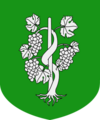Pacanesia
State of Pacanesia and Anesia Taheya o Pakaw e te Anaw'se (Pacanese) | |
|---|---|
| Motto: Na Taheya o' Na Taheya 'My Country o' My Country!' | |
| Anthem: "Prevail in the Seas" | |
| Capital and largest city | Jenni-Bahar |
| Capital-in-exile | Kahalie |
| Official languages |
|
| Regionalized language | Pohnpenesian |
| Ethnic groups (2005) |
|
| Religion |
|
| Demonym(s) | Pacanese |
| Government | Federal hereditary dictatorship under foreign control |
• President | Tariqua Abadul |
| Legislature | General Kiuva |
| Legally administrated by Pohnpenesia and Riamo as a joint territory, local government in exile since 2010. | |
• Kingdom of Pacanay | 1911 |
• Riamese mandate | 1924 |
• Independence | 1930 |
• Pacanese civil war begins | 2005 |
• Invasion of Pacanesia and Riamo-Pohnpenesian control | 2010- |
| Area | |
• Total | 9,029 km2 (3,486 sq mi) |
• Water (%) | 1% |
| Population | |
• 2023 estimate | 980,000 |
• 2005 census | 1,548,000 |
| GDP (PPP) | 2023 estimate |
• Total | $23.3 billion |
| GDP (nominal) | 2023 estimate |
• Total | $23.3 billion |
| Gini | low |
| HDI (2023) | medium |
| Currency | Riamese hull (RMH) |
| Time zone | UTC+6 |
| Date format | dd/mm/yyyy |
| Driving side | right |
| Calling code | +451 |
| Internet TLD | .pc |
Pacanesia, officially the State of Pacanesia and Anesia (Pacanese: Taheya o Pakaw e te Anaw'se) is an an archipelagic nation located in the southern fringes of the Kaldaz Ocean. The nation is made up of 20 islands in 2 archipelagos, 12 in Pacanesia and 8 in Anesia. According to the World Assembly, as of 2023, Pacanesia has an estimated population of approximately 980,000. In contrast, the pre-war census conducted in 2005 reported a population of 1,548,000 inhabitants. The capital and largest city is Jenni-Bahar, home to over 500,000 people—over 50% of the entire country's population. The de facto capital-in-exile is Kahalie, which used to be the largest city at over 700,000 before the civil war in 2005.
Of the 2005 population, 51% identified as ethnically White, while 29% identified as ethnically Pacanese. 22% are grouped into the "Ultramaro or other" category, which is primarily made up of Anáhuacese, Arab and Mixed people.

